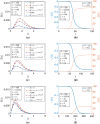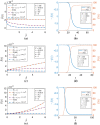Complete dimensional collapse in the continuum limit of a delayed SEIQR network model with separable distributed infectivity
- PMID: 32836812
- PMCID: PMC7352098
- DOI: 10.1007/s11071-020-05785-2
Complete dimensional collapse in the continuum limit of a delayed SEIQR network model with separable distributed infectivity
Abstract
We take up a recently proposed compartmental SEIQR model with delays, ignore loss of immunity in the context of a fast pandemic, extend the model to a network structured on infectivity and consider the continuum limit of the same with a simple separable interaction model for the infectivities . Numerical simulations show that the evolving dynamics of the network is effectively captured by a single scalar function of time, regardless of the distribution of in the population. The continuum limit of the network model allows a simple derivation of the simpler model, which is a single scalar delay differential equation (DDE), wherein the variation in appears through an integral closely related to the moment generating function of . If the first few moments of u exist, the governing DDE can be expanded in a series that shows a direct correspondence with the original compartmental DDE with a single . Even otherwise, the new scalar DDE can be solved using either numerical integration over u at each time step, or with the analytical integral if available in some useful form. Our work provides a new academic example of complete dimensional collapse, ties up an underlying continuum model for a pandemic with a simpler-seeming compartmental model and will hopefully lead to new analysis of continuum models for epidemics.
Keywords: COVID-19; Epidemic; Pandemic; Reduced order; Time delay.
© Springer Nature B.V. 2020.
Conflict of interest statement
Conflict of InterestThe authors declare that they have no conflict of interest.
Figures






Similar articles
-
Data suggest COVID-19 affected numbers greatly exceeded detected numbers, in four European countries, as per a delayed SEIQR model.Sci Rep. 2021 Apr 14;11(1):8106. doi: 10.1038/s41598-021-87630-z. Sci Rep. 2021. PMID: 33854165 Free PMC article.
-
COVID-19: data-driven dynamics, statistical and distributed delay models, and observations.Nonlinear Dyn. 2020;101(3):1527-1543. doi: 10.1007/s11071-020-05863-5. Epub 2020 Aug 6. Nonlinear Dyn. 2020. PMID: 32836818 Free PMC article.
-
New approximations, and policy implications, from a delayed dynamic model of a fast pandemic.Physica D. 2020 Dec 15;414:132701. doi: 10.1016/j.physd.2020.132701. Epub 2020 Aug 25. Physica D. 2020. PMID: 32863487 Free PMC article.
-
Delay differential equations for the spatially resolved simulation of epidemics with specific application to COVID-19.Math Methods Appl Sci. 2022 May 30;45(8):4752-4771. doi: 10.1002/mma.8068. Epub 2022 Jan 18. Math Methods Appl Sci. 2022. PMID: 35464828 Free PMC article.
-
Diffusion-reaction compartmental models formulated in a continuum mechanics framework: application to COVID-19, mathematical analysis, and numerical study.Comput Mech. 2020;66(5):1131-1152. doi: 10.1007/s00466-020-01888-0. Epub 2020 Aug 13. Comput Mech. 2020. PMID: 32836602 Free PMC article.
Cited by
-
Using simulation modelling and systems science to help contain COVID-19: A systematic review.Syst Res Behav Sci. 2022 Aug 19:10.1002/sres.2897. doi: 10.1002/sres.2897. Online ahead of print. Syst Res Behav Sci. 2022. PMID: 36245570 Free PMC article.
-
Data suggest COVID-19 affected numbers greatly exceeded detected numbers, in four European countries, as per a delayed SEIQR model.Sci Rep. 2021 Apr 14;11(1):8106. doi: 10.1038/s41598-021-87630-z. Sci Rep. 2021. PMID: 33854165 Free PMC article.
-
COVID-19: data-driven dynamics, statistical and distributed delay models, and observations.Nonlinear Dyn. 2020;101(3):1527-1543. doi: 10.1007/s11071-020-05863-5. Epub 2020 Aug 6. Nonlinear Dyn. 2020. PMID: 32836818 Free PMC article.
References
-
- Kermack WO, McKendrick AG. A contribution to the mathematical theory of epidemics. Proc. R. Soc. Lond. A Math. Phys. Eng. Sci. 1927;115(772):700–721.
-
- Hethcote, H.W.: The basic epidemiology models: models, expressions for R0, parameter estimation, and applications. In: Ma, S., Xia, Y. (eds.) Ma, S., Xia, Y. (eds.) Mathematical Understanding of Infectious Disease Dynamics, pp. 1–61. World Scientific (2009)
-
- Brauer F, Castillo-Chavez C, Castillo-Chavez C. Mathematical models in population biology and epidemiology. New York: Springer; 2012.
-
- Hethcote HW. The mathematics of infectious diseases. SIAM Rev. 2000;42(4):599–653. doi: 10.1137/S0036144500371907. - DOI
LinkOut - more resources
Full Text Sources
